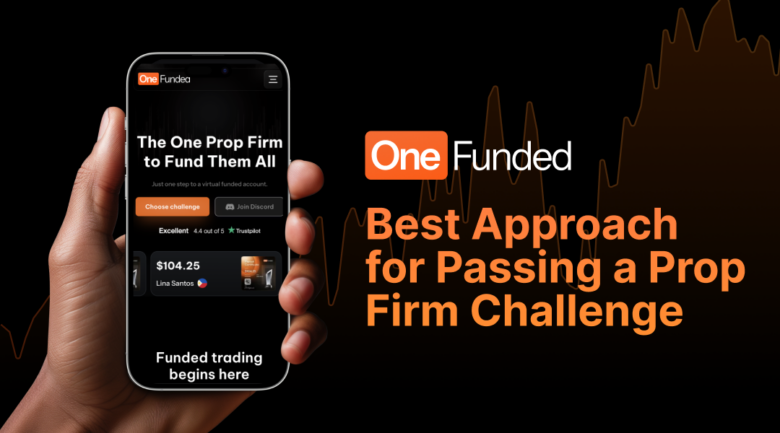How to Pass a Prop Firm Challenge: Rules, Mindset & Trading Plan Guide

2025-11-10 05:00:00
A prop firm is any financial institution that makes large amounts of capital available to traders for their trading activities in the hopes of securing profits that can be split between trader and firm. There are traditional prop firms that recruit traders through normal employment methods and pay them a salary. Then, there are new-age prop firms that operate almost completely online and recruit traders through a challenge or evaluation process.
So many traders wish for a world where they magically pass a prop firm challenge of their choice and become funded. However, as most come to realize, passing a prop firm challenge is not a walk in the park. The system is designed to allow only the most talented and disciplined traders into the various funded programs run by different firms.
Key Takeaways
- Passing a prop firm challenge is about discipline and risk management, not secret strategies.
- The rules of the challenge are designed to test your consistency, not just your ability to make a profit.
- You must have a simple, clear trading plan that you test thoroughly before starting. We will show you how to create a winning trading plan.
- Always know exactly what you will trade, when you will trade it, and how you will enter and exit.
- Set a personal daily loss limit that is stricter than the firm’s rule to stay safe.
Understanding Prop Firm Challenges
There are two sides to every prop firm challenge: the trader’s side and the firm’s side. Understanding both sides is key because prop firms are designed to be a win-win for traders and firms, not just one or the other.
The Why Behind the Challenge
Prop firms bear a huge portion of the risk when making trading capital available to traders, and they must ensure they’re investing in only the most talented traders who will better manage their capital. They can’t just take people’s words for it or assume that previous profitability will guarantee future earnings. The challenge/evaluation system was born from this need.
Prop firms define acceptable capital loss, target profit, and trading consistency, then encode these goals as rules in their unique challenge formats. Traders get demo accounts, analytical tools, and platforms to meet the firm’s goals (which differ slightly by firm). Typically you’ll see profit targets, daily and overall loss limits, and consistency requirements that mirror live-funded expectations. Challenges also help traders test discipline and avoid losing personal capital at scale without proven skills.
Deconstructing the Common Rules of Engagement
- Profit Target: A percentage of the initial balance that must be earned within the challenge. Many firms cap this at around 10%. Increasingly, firms offer no time limit, allowing you to take as long as needed.
- Maximum Drawdown: The maximum allowable loss before the account is deactivated (commonly ~8%–12%, depending on the challenge type).
- Daily Drawdown: A daily loss cap designed to enforce consistency and incentivize selective, high-quality trade selection.
- Minimum Trading Days: A requirement to demonstrate consistency over time, not just one outsized win.
- Time Limit: Many modern challenges now offer unlimited time; if there is a limit, it will be stated clearly.
The Two-Phase Structure: Evaluation and Verification
The most popular format includes Phase 1 (Evaluation) and Phase 2 (Verification). Hit the profit requirement while respecting loss limits, and you advance to Phase 2, where targets and limits are often slightly less stringent. This confirms repeatability rather than luck.
Static vs Trailing Drawdown
A static drawdown is calculated from the initial balance and does not move. A trailing drawdown moves up with your highest equity peak.
| Feature | Static Drawdown | Trailing Drawdown |
|---|---|---|
| Calculation Base | Initial Account Balance | Peak Account Equity |
| Behavior | Fixed, does not move | Moves upward as profit increases |
| Trader Implication | More breathing room as profits grow | Risk becomes tighter as you become more profitable |
Now that the rules are clear, note that mindset is the single most important factor for success as a prop firm trader.
Building the Right Mindset
The psychology of a consistently profitable funded trader differs from that of a regular trader. Before you buy a challenge, work on your mindset:
- Emotional discipline: Prop challenges amplify emotions (fear, greed, hope, revenge trading) due to larger capital and detailed analytics. You must manage these pressures.
- Choose process over outcome: A take-profit hit doesn’t always mean a quality setup or management. Focus on best-setup execution and management; profits follow process.
- Patience is a strategy: Wait for your ideal setup or don’t trade. Firms like OneFunded use no-time-limit challenges to reward patient, disciplined traders rather than clock-beating gamblers.
A strong mindset is essential, but you also need a feasible trading plan.
Crafting a Winning Trading Plan
Without a concrete plan, you’ll be reactive and prone to revenge trading. Build your plan first.
The Non-Negotiable Elements of Your Plan
Decide and demo-test the following before buying a challenge:
Markets and Instruments
Choose instruments based on demo results, then double-check with fresh backtests and forward tests. Only include instruments that repeatedly show positive results with your strategy.
Trading Session
Evaluate Tokyo, London, New York, and Sydney sessions. Track where you’re most alert and where your strategy performs best, then commit to those sessions.
Clear Entry and Exit Protocol
Most failures stem from unclear entries/exits, not bad strategies. If you trade trend breakouts, study many examples and define repeatable entry/exit levels that maximize realistic movement and appear consistently across your samples.
Risk-to-Reward Ratio
As a baseline, aim for at least 1:2. One win can offset two losses, easing the path to the profit target.
The Power of a Simple, Tested Strategy
- Easy to remember
- Quick to execute
- Fewer opportunities for error under pressure
Simple and mastered beats complex and fragile.
Backtesting and Forward-Testing with the Prop Firm Rules
Demo test with your chosen firm’s exact rules (profit requirement, daily/overall drawdown, consistency) for 2–4 weeks. Prove consistent profitability within those constraints before paying for a challenge. Journaling is critical here.
The Role of a Trading Journal
Log results, emotions, and plan adherence. Your journal should reveal strengths, weaknesses, and performance over fixed windows. Pros treat journaling as seriously as execution.
Risk Management Techniques
Excellent strategies still fail without disciplined risk management.
1. Position Sizing
Risk a small, fixed percent per trade (commonly 0.5%–1%) depending on your R:R. Calculate position size using your account size, risk %, stop distance, and instrument. Most platforms and third-party sites provide free position-size calculators.
2. The Unbreakable Stop-Loss and Realistic Risk-to-Reward
Use a stop-loss on every trade. Pair with take-profit targeting at least 1:2. With 40% win rate and 1:2 R:R, you can still end profitable across a sample.
3. Managing Daily Drawdown
Set a personal daily loss limit tighter than the firm’s. If the firm’s is 5%, consider stopping at 2%–3% to preserve the account. When you hit it, close platforms and walk away.
Technical and Strategy Preparation
Be methodical once live.
The Art of Consistency and Patience
The “Minimum Trading Days” rule forces patience and time-distributed progress. Treat the challenge like a job: show up during planned sessions, execute only ideal setups, and log off if none appear.
Avoiding Tactical Errors
- Overtrading: Taking non-ideal setups out of boredom or impatience.
- Revenge Trading: Jumping back in to win back losses immediately.
- Strategy Hopping: Abandoning your plan after a few losses; this prevents mastery.
Navigating Different Market Conditions
Define what a good trade looks like in volatile vs. quiet markets. Widen stops (and reduce size) in volatility; accept fewer setups in quiet periods. Never force trades.
Common Mistakes and How to Avoid Them
- Ignoring drawdown type: Know whether your challenge uses static or trailing drawdown before placing the first trade.
- Over-leveraging: High leverage isn’t a requirement. Be conservative.
- Chasing the profit target: Don’t force to hit 10% quickly. Execute your plan and let profits accrue.
- Starting without practice: Don’t pay for a challenge until you’ve proven consistent demo profitability under the firm’s rules.
Conclusion
The best approach to passing a prop firm challenge rests on a few principles: unwavering discipline, absolute risk control, a detailed and tested plan tailored to your chosen firm’s rules, and patience to let profits compound. Success is built on consistent habits — not shortcuts or secret indicators. Do the right things, trade after trade, day after day.




